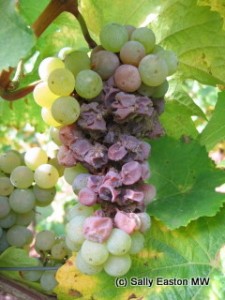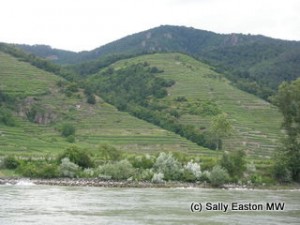To B(otrytis) or not to B(otrytis)? That is the question
An infection of botrytis, or noble rot, is well known, and much sought-after, to produce some of the world’s best and most complex sweet white wines, such as Sauternes, the Loire stickies, Alsatian Sélection de Grains Nobles, as well as Germany’s beerenauslese and trockenbeerenauslese wines. De Bortoli’s Noble One is Australia’s icon wine in this style.
But what about using a small proportion of ‘good botrytis’ in dry white wines, notably riesling but not restricted to this variety? So-called ‘good botrytis’ because it is the same mould as that which causes grey rot/bunch rot/bad botrytis, where infected grapes must be thrown away because they give a rotten fruit taste to wine.

Bunch with healthy grapes and botrytis-affected grapes
There are two schools of thought on this issue, which Roman Horvath MW, the managing director of Domäne Wachau outlined for the Wachau region of Austria, saying some producers, such as “Franz Hirtzberger work with botrytis. I call them the masters of botrytis. There has to be a very exact picking time, almost with half-day precision. And with even more picking passes through the vineyard. Others, such as Rudi Pichler, focus on elegance, minerals, purity and precision. We are more on the side of Rudi Pichler and Alzinger.”
Indeed for the 2009 vintage Mathias Hirtzberger of Weingut Franz Hirtzberger said “usually we use 5 to 10% botrytis. These are wines for 10 years’ ageing, and our smaragds will age for much more. The wines have a lot of alcohol, acid and sugar as we aim to harvest the grapes very ripe. It’s always about the taste.”
Such use of ‘good’ or ‘dry’ botrytis usually results in wines of higher alcohol, 14 to 14.5%, rather than 13 to 13.5%. The wines are more concentrated, with greater weight, though not necessarily with more residual sweetness to them, as this is likely to have been fermented out. Lucas Pichler, the winemaker at Weingut F.X. Pichler explained further, saying with good botrytis you get “more deepness, more extract, especially for riesling. It’s not so important for grüner veltliner because you lose a bit of the pepperiness of grüner veltliner.”
It’s this potential masking effect that deters other producers. Leo Alzinger of Weingut Alzinger explained “we use dry botrytis as little as possible. The wines are more focused without botrytis. They are more reflective of their terroir. Wines start to age after one year with botrytis. And with more botrytis there is more alcohol, plus aromas which cover the terroir.”
Cleanliness of fruit and precision of focus are important drivers for ‘no-botrytis’ proponents. Also in the Wachau, Peter Veyder-Malberg of Weingut Veyder-Malberg said “botrytis destroys the character of the grapes and the character of vineyard. With riesling, when I see bunches start with botrytis, I cut the whole bunch and make the wine, leaving other [completely healthy] bunches on the vine. Three weeks later I can harvest sound bunches. But it means I harvest quite early.” He added “I tell my workers to select each berry which they would choose not to eat and throw it away.”

Wachau vineyards close to river Danube
The ‘to B or not to B’ question appears most pertinent for the Wachau, at the western, coolest extreme of Danubian viticulture in Austria, where the vineyards are close to the river and botrytis is more likely to creep into the vines at the end of the growing season. Horvath said “botrytis is part of the microclimate here [Wachau] in October. You can’t avoid it.”
Almost next door to the Wachau, in Kamptal, where the vineyards are a little bit further from the mist-creating river, said Willi Bründlmayer, of Weingut Bründlmayer, “Kamptal has a tradition to work without botrytis.” Though he’s not dogmatic on the question, adding “In 2001 we harvested with botrytis because it was a high acid year and the botrytis softened it out to balance the wine. Normally it’s not our style [to use botrytis]. I like straightforward, clean grapes.”
Bründlmayer also believes botrytis masks terroir effects saying “It should taste like riesling, like Heiligenstein, like the vintage. Botrytis gives complexity, makes you a winner in a blind tasting, but if you want to drink the wines, then you need no botrytis.”
Fellow Kamptal vintner Weingut Hiedler has moved away from this winemaking style. Maria Angeles Castellanos-Hiedler said “we used to use dry botrytis. In the last five years we’ve refined the winemaking and now try to have as little as possible. We like to have clear wines. The botrytis means the wine is not ‘quiet’, it tastes very spicy. We want clear and clean tastes.”
This theme was picked up by Johannes Hirsch of Weingut Hirsch, who said “botrytis lays over the terroir, it hides typicity”, adding “petrol notes come earlier with botrytis.”
The subject came up at a May 2010 Global Riesling tasting in Vienna, hosted by the Institute of Masters of Wine. Rowald Hepp, managing director of Schloss Vollrads in the Rheingau region of Germany, said “botrytis can add complexity in dry riesling, but makes it more difficult to keep single vineyard expression. Terroir and botrytis is a tricky pairing. We avoid it in our dry wines.”
Ultimately the use of dry botrytis is just one winemaking option with a resulting style outcome. If the complexity imparted by botrytis adds layers of interest, dimension and texture to a wine that the drinker enjoys, it doesn’t matter if terroir or even varietal character is obscured. Some would argue terroir obscures varietal character. It depends on what the winemaker wants to achieve.
If the wine is tasty, job done, with or without botrytis.



